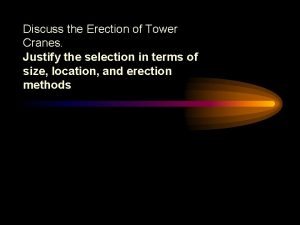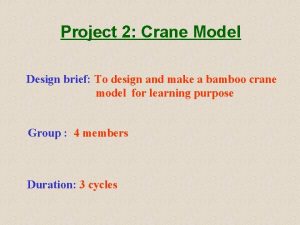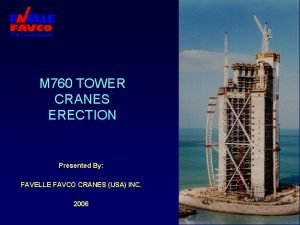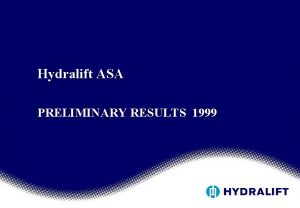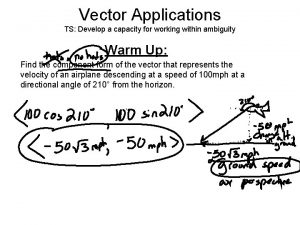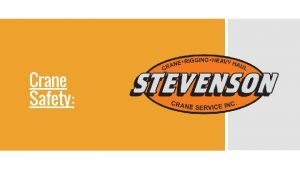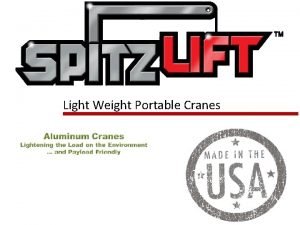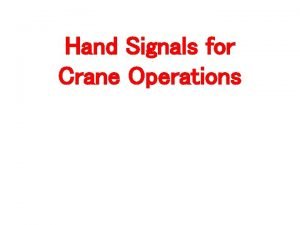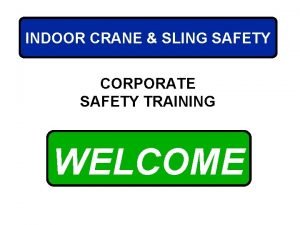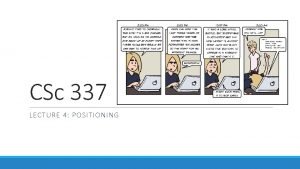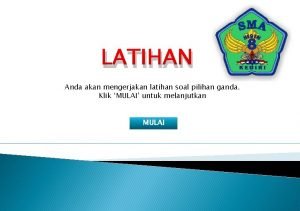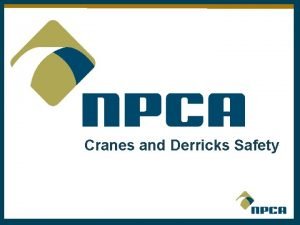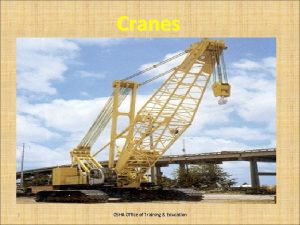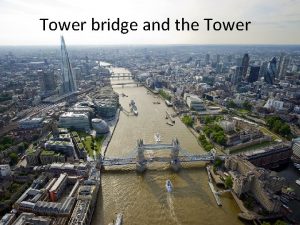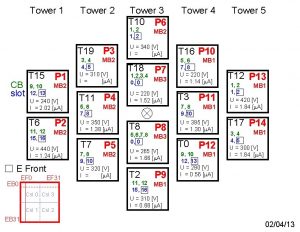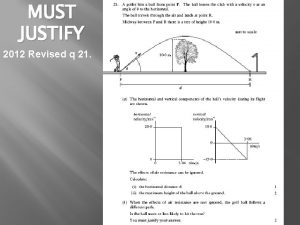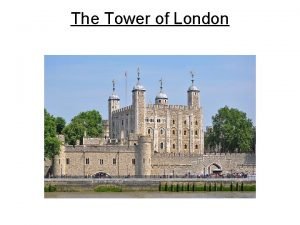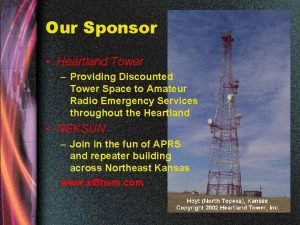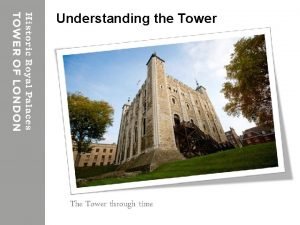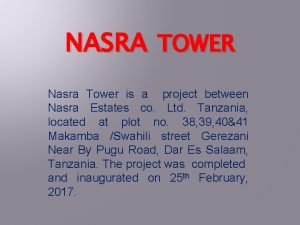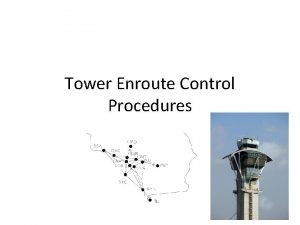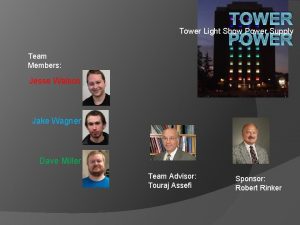Discuss the Erection of Tower Cranes Justify the


































































- Slides: 66

Discuss the Erection of Tower Cranes. Justify the selection in terms of size, location, and erection methods

COMMON CRANE TYPES Truck Mounted Cranes • loading / unloading purposes • may be attached with telescopic or lattice arms, slewing or fixed

COMMON CRANE TYPES Mobile Crane • • normally fitted with strut (lattice) or hydraulic jibs common for them to come with a flying jib as well difficulties in accurate positioning of components such as cooling towers at top of building limited site coverage

COMMON CRANE TYPES Climbing Crane • • climb up a shaft within a building using a limited number of mast sections strategic coverage yet maximizing land use in congested sites

COMMON CRANE TYPES Gantry Crane • • jib supported on a 4 -legged portal carried on rails with adjustable height for flexibility normally used for material handling in the construction of caissons

COMMON CRANE TYPES Tower Crane • • • extensive coverage ability to transport materials quickly across the site low capacity (as compared to mobile cranes) as a result of their slenderness Goliath Cranes

TYPICAL COMPONENTS OF A TOWER CRANE All tower cranes consists of the same basic parts BASE • bolted to a large concrete pad that supports the crane • connects to the mast (or tower)

TYPICAL COMPONENTS OF A TOWER CRANE MAST • the “body” of the crane that gives its height

TYPICAL COMPONENTS OF A TOWER CRANE SLEWING UNIT • gear and motor that allows the crane to rotate

TYPICAL COMPONENTS OF A TOWER CRANE JIB • • the portion of the crane that carries the load a trolley runs along the jib to move the load in and out from the crane's center

TYPICAL COMPONENTS OF A TOWER CRANE BOOM ARM contains : • crane's motors that lifts the load • control electronics • cable drum • large concrete counter weights

TYPICAL COMPONENTS OF A TOWER CRANE OPERATOR CABIN

VARIATIONS TO THE TYPICAL COMPONENTS • Counter weights may be fixed at the ground level. This is normally done in situations where the load to be lifted by the tower cranes changes frequently

VARIATIONS TO THE TYPICAL COMPONENTS Derricking (Luffing) Crane • • exceptionally tall buildings or in very restricted spaces able to slew through 360 o under load at only 8 m slewing radius compact slewing radius and steep jib angle (between 15° and 70°) suitable for use on confined sites where several cranes have overlapping slewing radii

DIFFERENT SERIES OF TOWER CRANES The H series The TT series The K series The A series H, TT and K series of bottom-slewing cranes are designed as fast-erecting cranes and are ideal for small, narrow building sites. Lifting capacities of up to 120 metric ton can be handled with hook heights of up to 34 m

DIFFERENT SERIES OF TOWER CRANES The LC series The EC / EL series The EC-B series The EC-H series The LC and EC / EL- top-slewing cranes are particularly easy to transport and assemble. The construction series ranges from 30 to 100 metric ton, with trolley jib extensions from 30. 0 to 52. 5 m

DIFFERENT SERIES OF TOWER CRANES The HC series The HC-L series The HC-T series The HC-K series The top-slewing cranes in the HC series are general-purpose cranes for use in medium- to large-scale construction projects of all kinds. The series covers capacities from 800 to 5, 000 metric ton with luffing or telescopic jib lengths of up to 100 m; maximum loads of 80 ton and free traveling hook heights of up to 110 m.

LEGISLATION CP 62: 1995 Code of Practice for safe use of tower cranes Section 2 Operational Conditions • Sitting and General Safety Considerations -- adequate soil bearing capacity -- should not encroach upon public areas -- cranes must not be in the way of aircraft flight path -- adequately grounded and protected from lightning

LEGISLATION Operational Conditions • Stability -- data on the maximum forces acting at the crane’s base -- crane’s dead weight, weight of attachments and the maximum dynamic forces -- estimates on wind load -- must be plumped • Proximity Hazards -- site boundaries -- slewing limits switches could be used to restrict jib movements -- trolleying limits switches -- jib of higher crane must be at least 2 m above the top of lower crane when 2 or more cranes are used -- jib of one crane should not interfere with the mast of another crane

LEGISLATION Operational Conditions • Erection and Dismantling -- sufficient working space -- inspection by competent engineer before erection and by relevant authorities -- check all bolts, locking devices, wire ropes, indicators, alarms, other safety devices, ladders, platforms, walkways, handrails, etc -- anchorage should be used when the crane exceeded free standing height -- radius indicator and load capacity chart must be fixed -- load limit switch must be fixed

LEGISLATION • Operation and Control -- should not be used for dragging and pulling of load, inclined load, piling work, demolition -- load capacity chart -- operator and signaler -- when crane is unattended, all loads must be unloaded and hook raised to highest position and minimum radius -- tag lines


LEGISLATION Section 3 Maintenance, Inspection and Repair -- logbook should be maintained for each crane -- routine inspection should be made on parts of the crane -- all cranes are required by section 31(2) of the Factories Act to be thoroughly examined by an approved person at least once in every 12 months -- any parts of the crane which is damaged and worn should be repaired or replaced with out due delay and should comply with manufacturer’s specification

Installation of Tower Cranes Submission Checklist 1. Site plans showing position of cranes. 2. Technical data for the tower cranes, including maximum in-service and out-of-service overturning and torsional moments, self-weight, horizontal reaction, and jib length. 3. Contractor's P. E. 's calculations and design drawings for the foundation. 4. A diagram of the crane indicating the location and types of safety devices to be installed. 5. Method statement on the system of communication between the riggers (banksmen) and the crane operator. 6. Clearances from relevant authority (eg. Ministry of Labour and Ministry of Defence) for the layout and height of cranes. 7. Documents showing that the height of the crane is within the limits imposed by the relevant aviation authority (eg. the Civil Aviation Authority of Singapore). 8. Latest 3 months' maintenance certificates. 9. Name of the riggers who shall be formally trained and shall possess the Certificates of Training from an approved authority. 10. Names of supervisors to supervise the use of the cranes. 11. Name list of authorized crane operators. 12. Certificates of competency for the crane operators. 13. Rules for the safe use of the cranes. 14. Capacity charts for each type of crane to be used

Guide to Carrying out Restricted Activities within the Railway Protection and Safety Zones

TOWER CRANE ACCIDENTS DO HAPPEN

LEGISLATION Code of Practice, Safety and Health of Construction Worksites Part I, 1985 Chapter 9 – Lifting appliances and Equipment Section 5. 3 and 5. 6 • Structure -- Crane should be made from materials that absorb shock such as mild steel -- Cabin should be made of fire resisting material and provided with a fire extinguisher -- Access to the cabin should be from a safe place in the crane

LEGISLATION Section 5. 3 and 5. 6 • Anchorage and ballast -- Every fixed crane should either be securely anchored or be adequately weighed by suitable ballast firmly secured to ensure stability -- Counterweights should be so arranged that they do not subject the backstays, sleepers or pivots to excessive strain

LEGISLATION Section 5. 3 and 5. 6 • Load and radius indicator -- The maximum permitted angle of inclination of the crane jib must be clearly marked on the crane • Operation -- Jib cranes should not be moved or operated in dangerous proximity to electric power lines

Erection Procedures (refer to Video Clip and Report for comprehensive guide)

Dismantling Procedures (for telescopic, self jacking tower crane)

Inner mast Hydraulic Jacking Cage Outer mast

Hydraulic Jacking Cage jacks inner mast downwards First section bolts released Bolts to secure the inner mast to the second section of the outer mast

First section mast will be removed

Hydraulic Jacking Cage will be jacked downwards

Hydraulic Jacking Cage is now in position of first section Inner mast is jacked downwards

DISMANTLING Case Study : Proposed 30 th storey HDB site along Joo Chiat Road • Singapore’s first pre-cast water tanks to be installed in HDB flats • Water tanks to be positioned on top of flats • Heavy load capacity profile • K-4 series self-jacking crane chosen

DISMANTLING Fitting of the Hydraulic Jacking Cage to the inner mast The Hydraulic Jacking Cage is fitted to the inner mast by using bolts and the sections of the Hydraulic Jacking Cage are hoisted up by the crane itself

DISMANTLING Start of the Jacking Down Process Securing the inner mast to the second section of main mast to ensure effective load transfer

DISMANTLING Right now, the entire jib arm is resting on the second main mast section, which allow the first section to be safely lifted up and dismantled

DISMANTLING After the inner mast have been secured to the second section of the main mast, the bolts securing the first main mast section to the second will be removed

DISMANTLING The Hydraulic Jacking Cage will be activated and jacked upwards to release the first section of the main mast from the second section

DISMANTLING With all the bolts removed, the first main mast section will be lifted off from its position Bottom view of the main mast Top view of the main mast

DISMANTLING Removal of the lynch pin which is holding the first section of the main mast together

DISMANTLING Lifting off the dismantled section and bringing it down to the ground by using the crane itself

DISMANTLING Lowering down of the Hydraulic Jacking Crane to the second main mast section Securing the Hydraulic Jacking Cage to the second main mast section

CRANE SELECTION Which crane to use ? Tower? Mobile? Climbing? ? Selection determinants Location Structure Utilization Availability

CRANE SELECTION Structure • • Tall or short Widespan Support for crane (tower and climbing) Complexity of design (slewing, luffing, rotating limits)

CRANE SELECTION Location • • • Site layout Site area – outside or within building footprint ? ? Vehicular access ( 10 to 15 m from site entrances ) Coverage – ideally approaching 100% Soil conditions Space to assemble and disassemble

CRANE SELECTION Utilization Crane Configuration Two main determinants • Lifting weight • Lifting distance – height and reach Use load charts to determine crane configuration capabilities

CRANE SELECTION Load Chart Conditions • Jib and boom extensions not installed • Jib and/or boom extensions installed but load is lifted from the main boom • Jib and/or boom extensions installed and load is lifted from either

CRANE SELECTION Factors Affecting Conditions • Weight to be lifted • Crane Base Geometry & Configuration • Crane Configuration • Quadrant(s) of Operation (mobile crane) • Boom Length • Load Radius • Deductions from Gross Capacity

CRANE SELECTION Availability • Financial resources • Market availability

a Liebherr 390 HC horizontal jib tower crane located in Las Vegas, NV on the Stratosphere (tallest structure in Nevada); final hook height of 1120'; it is being used to construct the roller coaster and radio tower on the top of this restaurant. It has a forward jib and a rear jib with a trolley running on the forward jib controlling the hoisting cable

In 1995 Sheedy received the SC&RA Rigging Job of the Year Award for removing a Liebherr 390 HC tower crane from the Stratosphere Tower in Las Vegas, Nevada In order to remove the tower crane, at an elevation of 1200 ft. , a detailed engineering plan was developed and implemented

a Liebherr 550 C rail-traveler horizontal jib tower crane located at Houston Intercontinental Airport, Houston, TX; the tracks provide a much greater working range; the construction of the tracks is quite substantial and provision has to be made for use or removal when the crane is removed

this is how a tower crane can be attached temporarily to an existing structure to give the tower of the crane stability

two Liebherr 500 HC-L luffing boom tower cranes used on the Luxor Hotel & Casino in Las Vegas, NV. Why would a horizontal boom not be used?

NB. Pls refer to report and video clip CASE STUDY 1: SCOTTS WALK Need for Tower Crane? Facts and figures: • The extension of the Royal Hotel is on the right wing of the site. • Left wing is for A&A. • Right wing had been demolished for a new 5 -storey extension of the Royal Hotel. • Site dimension approx 40 m by 30 m. • Piling had already been done. • Congested Site. • Tower Crane is needed, as congested site do not allow easy movement of mobile crane

CASE STUDY 1: SCOTTS WALK

CASE STUDY 2: GRANGE RESIDENCES NB. Pls refer to report and video clip Facts: • Along Tanglin Road • Considered relatively uncongested site • Extensive coverage of materials transportation and handling necessary due to system formwork chosen • Height of buildings did not justify climbing cranes • Considerations for vehicular access and load capacity • Number, type and location of tower cranes to utilise

CASE STUDY 2: GRANGE RESIDENCES Blk B Blk A Blk C

Blk B Blk A Blk C

Blk A Blk B Blk C

Blk A Blk B Blk C

The End
 How erection happens
How erection happens Erection hardness scale
Erection hardness scale Boobs erection
Boobs erection Method statement for tower crane installation
Method statement for tower crane installation Amateurs discuss tactics professionals discuss logistics
Amateurs discuss tactics professionals discuss logistics Write a design brief for a crane
Write a design brief for a crane Red cranes by jacey choy questions and answers
Red cranes by jacey choy questions and answers Favco cranes history
Favco cranes history Hydralift offshore cranes
Hydralift offshore cranes Three cranes grove
Three cranes grove The cranes shown in the figure are lifting an object
The cranes shown in the figure are lifting an object Osha rules on lightning and cranes
Osha rules on lightning and cranes Cranes for pickup trucks
Cranes for pickup trucks Sadako door
Sadako door Hand signals for cranes
Hand signals for cranes Which class chose sadako to be on the relay team?
Which class chose sadako to be on the relay team? Cranes short story theme
Cranes short story theme Indoor cranes safe lifting operations
Indoor cranes safe lifting operations How did robber barons justify their wealth
How did robber barons justify their wealth Food quality importance
Food quality importance What is the difference of actual self and ideal self
What is the difference of actual self and ideal self Justify the title keeping quiet
Justify the title keeping quiet Odysseus mother's name
Odysseus mother's name Compromise enables maine and missouri
Compromise enables maine and missouri Css float vs flex
Css float vs flex Unscramble settler
Unscramble settler Socialization is a lifelong process justify the statement
Socialization is a lifelong process justify the statement Do computers surpass man's intelligence? justify
Do computers surpass man's intelligence? justify Perubahan gambar di atas dibuat menggunakan efek
Perubahan gambar di atas dibuat menggunakan efek Stop trying to justify yourself
Stop trying to justify yourself Bàn tay mà dây bẩn
Bàn tay mà dây bẩn Khi nào hổ mẹ dạy hổ con săn mồi
Khi nào hổ mẹ dạy hổ con săn mồi Dạng đột biến một nhiễm là
Dạng đột biến một nhiễm là Các châu lục và đại dương trên thế giới
Các châu lục và đại dương trên thế giới Bổ thể
Bổ thể Ví dụ giọng cùng tên
Ví dụ giọng cùng tên Thiếu nhi thế giới liên hoan
Thiếu nhi thế giới liên hoan Phép trừ bù
Phép trừ bù Thể thơ truyền thống
Thể thơ truyền thống Bài hát chúa yêu trần thế alleluia
Bài hát chúa yêu trần thế alleluia đại từ thay thế
đại từ thay thế Vẽ hình chiếu vuông góc của vật thể sau
Vẽ hình chiếu vuông góc của vật thể sau Sơ đồ cơ thể người
Sơ đồ cơ thể người Số nguyên là gì
Số nguyên là gì Công thức tính thế năng
Công thức tính thế năng Tỉ lệ cơ thể trẻ em
Tỉ lệ cơ thể trẻ em Vẽ hình chiếu đứng bằng cạnh của vật thể
Vẽ hình chiếu đứng bằng cạnh của vật thể ưu thế lai là gì
ưu thế lai là gì độ dài liên kết
độ dài liên kết Quá trình desamine hóa có thể tạo ra
Quá trình desamine hóa có thể tạo ra Kể tên các môn thể thao
Kể tên các môn thể thao Hát kết hợp bộ gõ cơ thể
Hát kết hợp bộ gõ cơ thể điện thế nghỉ
điện thế nghỉ Nguyên nhân của sự mỏi cơ sinh 8
Nguyên nhân của sự mỏi cơ sinh 8 Từ ngữ thể hiện lòng nhân hậu
Từ ngữ thể hiện lòng nhân hậu Trời xanh đây là của chúng ta thể thơ
Trời xanh đây là của chúng ta thể thơ Tư thế ngồi viết
Tư thế ngồi viết Voi kéo gỗ như thế nào
Voi kéo gỗ như thế nào Fecboak
Fecboak Một số thể thơ truyền thống
Một số thể thơ truyền thống Khi nào hổ mẹ dạy hổ con săn mồi
Khi nào hổ mẹ dạy hổ con săn mồi Diễn thế sinh thái là
Diễn thế sinh thái là Thế nào là hệ số cao nhất
Thế nào là hệ số cao nhất Slidetodoc
Slidetodoc Tư thế ngồi viết
Tư thế ngồi viết Thế nào là mạng điện lắp đặt kiểu nổi
Thế nào là mạng điện lắp đặt kiểu nổi đặc điểm cơ thể của người tối cổ
đặc điểm cơ thể của người tối cổ



